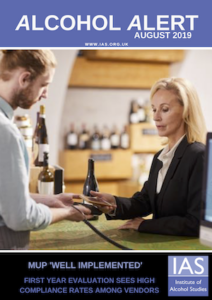In this month’s alert
Editorial – August 2019
Welcome to the August 2019 edition of Alcohol Alert, the Institute of Alcohol Studies newsletter, covering the latest updates on UK alcohol policy matters.
This month, NHS Health Scotland’s evaluation of MUP finds the policy has been well implemented since its introduction.
Other articles include: Abertay Uni Student Union bar becomes the first in the UK to stop selling alcohol ‘because of falling demand’, official statistics find underage drinking is influenced by parents, and that progress made in reducing drink-driving deaths and injuries continues to slow.
Please click on the article titles to read them. We hope you enjoy this edition.
COVER STORY – MUP ‘well implemented’ in first year
First evaluation of pricing policy finds high rates of compliance
01 August 2019 – Minimum Unit Pricing (MUP) for alcohol has been implemented effectively in Scotland, according to NHS Health Scotland, with local authority representatives noting high compliance rates among licensed premises.
This is the first study from the MUP Evaluation Portfolio, an ongoing project designed to assess the social and health impacts of MUP. Researchers conducted telephone interviews with 12 Licensing Standards Officers (LSOs), five Police Scotland local divisional licensing officers, and three Trading Standards Officers (TSOs).
Elinor Dickie, public health intelligence adviser at NHS Health Scotland, who wrote the report, said: ‘Minimum unit pricing has the potential to improve Scotland’s relationship with alcohol and reduce the harm it causes.
‘But MUP in the form we have it in Scotland hasn’t been put it in place anywhere before. That’s why it’s so important to gather evidence of its impact through a robust and comprehensive evaluation.
‘This study represents a crucial foundation for the rest of our evaluation. Successful implementation is an important first step for any policy to achieve its intended outcome. Having now established that MUP was well implemented and compliance is high, we can be confident in assessing findings from other studies in the evaluation portfolio on the extent to which MUP has affected other outcomes.’
Respondents expressed their satisfaction with licensed premises’ adoption of the new legislation from 01 May 2018. In retrospect, concerns were raised over the ‘limited lead-in time’ between the announcement that MUP would go ahead and the start date and the availability of guidance for premises, but any issues of non-compliance with MUP were ultimately considered to be minor. Non-compliance was not found to be an issue among on-trade premises (eg pubs, hotels), and all issues of non-compliance in the off-trade (off-licence shops, supermarkets) were swiftly resolved. No increases in illegal alcohol-related activity were found as a result of the introduction of MUP.
Researchers also identified a number of factors that supported the high level of compliance:
- the mandatory status of MUP. This means that all premises must comply as a condition of their alcohol licence
- the level at which MUP was set (£0.50p) means it had limited effect on the on-trade and only affected a comparatively small proportion of alcohol products in the off-trade
- the financial incentive for licensed premises to comply, both to protect their licence, and because MUP is perceived to increase their income
- the role of the LSOs, together with the police licensing division and TSOs, in supporting compliance. The practical resources made available, such as the guidance produced by the Scottish Government and Scottish Grocers Federation, were also felt to have helped licensed premises.
Chairman of the National Licensing Standards Officers’ Network Douglas Frood said: ‘Practitioners felt the trade were receptive to the new condition, and highlighted both the level of engagement amongst licence holders and their willingness to comply with the legislation.
‘The finding that no known increase in illegal and unlicensed alcohol activity related to the introduction of MUP was reported is also to be welcomed.’
A series of further evaluations of MUP will be published before the end of 2019, including analysis of sales data and the impact of the policy on children and young people.
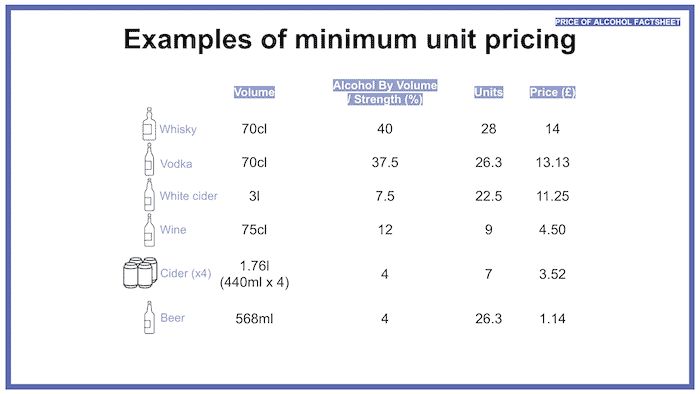
Prices of different alcoholic beverages under a minimum unit price of 50 pence per unit. |
You can hear Dr Peter Rice talk about how the policy is implemented in our Alcohol Alert podcast.
Nearly 20,000 new alcohol-related cancer cases in England
Indicators added to the LAPE tool
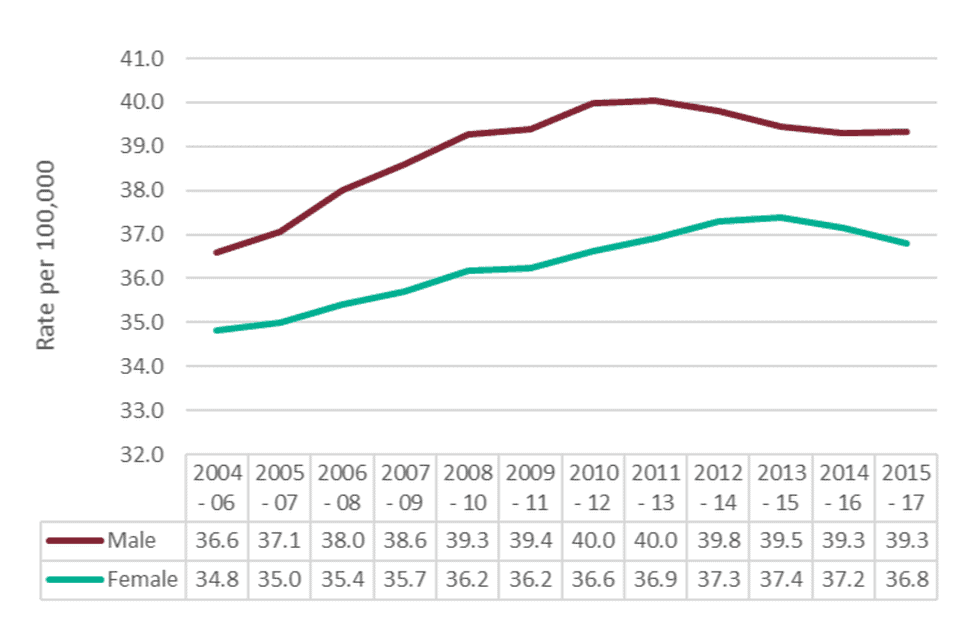
Rate of new alcohol-related cancer cases, by sex. |
06 August 2019 – New data published by Public Health England suggest that there were 58,200 new alcohol-related cancer registrations between 2015 and 2017, equating to approximately 19,400 new cancer cases each year.
This is one of two updates to the Local Alcohol Profiles for England (LAPE) tool, the other being the number of premises licensed to sell alcohol per square kilometre.
The rate of new alcohol-related cancer cases between 2015 and 2017 for both men (39.3 cases per 100,000 population) and women (36.8) remains the same as over the previous time period calculated, 2014-2016, and represents a slight decrease from their respective peaks (2011-2013 for men and 2013-2015 for women).
Geographically, 2015-2017 alcohol-related cancer incidence rates were highest in the north west regions of Manchester (49.4 per 100,000) and Blackpool (48.8 per 100,000), while London boroughs Westminster (28.8 per 100,000) and Kensington and Chelsea (29.6 per 100,000) had the lowest.
The LAPE tool now includes the number of premises with certificates permitted to sell or supply alcohol on-trade or off-trade per square kilometre for each local authority in England. By including this data in LAPE, local authorities can compare the number and density of licensed premises in their area with similar areas and with areas experiencing similar harms.
For 2017 to 2018 there were 164,857 premises across England licensed to sell alcohol. With the exception of Blackpool, the areas with the greatest density of premises typically mirrors population density, meaning London and the major cities have the greatest number of licensed premises per km².
Strict alcohol policy environments may reduce intimate partner violence
Tougher policies linked to less drinking among IPV homicide victimes
08 August 2019 – A recent study in the American Journal of Preventive Medicine explored associations between alcohol policy environments and the likelihood of victims of intimate partner violence homicide having drunk alcohol. This builds on previous work by the same team which identified more restrictive alcohol policy environments were linked to lower rates of alcohol-related homicides and traffic fatalities.
The study used the Alcohol Policy Scale – which measures the presence of 29 different alcohol policies – alongside US homicide data with blood alcohol concentration from two types of intimate partner violence victims: 2,901 primary victims who had been in a relationship with the perpetrator, and 1,181 corollary victims (primarily acquaintances). Overall, 36.5% of primary victims and 41.1% of corollary victims had a blood alcohol concentration (BAC) >0.00%. Of the victims with a positive BAC, 67.6% had a BAC ≥0.08% (or 0.08 grams per decilitre, the National Institute on Alcohol Abuse and Alcoholism’s definition of binge drinking).
In the main analysis, a 10-percentage point increase in the Alcohol Policy Scale – roughly equivalent to going from the 25th to the 75th percentile in terms of policy restrictiveness – was associated with 23% reduced odds of any alcohol involvement among intimate partner violence homicide victims. These estimates were similar among primary and corollary victims, and the relationship was also present among victims with a blood alcohol concentration >0.08%.
This study highlighted that corollary victims are an ‘important, yet overlooked dimension of intimate partner violence homicide’. While this study does not prove a causal link between the policy environment and alcohol involvement in intimate partner violence homicide, the authors suggest the alcohol policy environment should be considered a priority in preventing and intervening in this issue.
Scientists untangle links between genes and alcohol intake
Adapted from Imperial College London website
13 August 2019 – Scientists have shed light on the complicated relationship between the makeup of our DNA and how much alcohol we drink.
In the first study, published in Nature Human Behaviour, the international team, led by Imperial College London, identified new genetic markers associated with alcohol intake.
After analysing data from around 500,000 people – most aged between 40-69 – the team identified 46 new genetic markers linked to how much alcohol people drink.
The researchers found these genetic factors could account for 7% of the variation in people’s total alcohol intake. Those with the lowest alcohol-related genetic risk drank about one third less of a standard drink per day (2.6g of alcohol) compared with those with the highest.
The team also identified genetic pathways shared between alcohol intake and brain networks, in particular networks associated with psychiatric disorders such as schizophrenia. This could suggest that a person’s alcohol intake and their risk of schizophrenia may be influenced by some of the same genes.
Professor Paul Elliott, lead author of the study from Imperial’s School of Public Health, said: ‘This study suggests the amount we drink is not just socially determined, but also has a biological basis.’
He continued: ‘Although we already knew there was an association between schizophrenia and alcohol drinking, this research suggests there may be some joint genetic mechanism that leads a person to drink more, as well as increase their risk of schizophrenia.’
The paper also revealed one particular genetic variant was linked to size of a brain region called the putamen, which was in turn linked to alcohol intake.
Professor Elliott added that the research was based on data from people with European ancestry, and so data from other ethnicities should also be investigated. But the research furthers our understanding of our complicated relationship with alcohol:
‘Excessive alcohol consumption is a major public health problem, and associated with around one in 20 deaths worldwide.
‘If we understood more about the biology of why we drink alcohol, we may be able to understand more on how to effectively deal with alcohol issues.’
Abertay Uni watering hole goes dry
Selling alcohol no longer viable for Student Union bar
15 August 2019 – Alcohol seems no longer to be in vogue – at Abertay University, that is. According to media reports, alcohol sales at the Student Union bar, which opened in 2005, have plummeted two thirds since 2013/14, leading to its closure ahead of the new university year.
This makes Bar One ‘the first Student Union bar in the UK to stop selling alcohol because of falling demand’.
An Abertay spokesperson said: ‘We recognise that student tastes have shifted away from a bar setting and towards a daytime café offering. Just last year we opened a new Library Café as part of the £5m refurbishment of the Bernard King Library, which has been a success with both students and staff.
‘In contrast, sales income in Bar One has dropped by two thirds in the last five years, and from September we will no longer offer food or drink provision in this area.’
The story comes amid a backdrop of wider declines in alcohol consumption among young adults. Official figures suggest that the proportion of young adults (16–24 years of age) shunning alcohol entirely is higher than it was a decade ago, while a 2018 survey by the National Union of Students (NUS) revealed that demand for alcohol-free university events is on the rise.
Eva Crossan Jory, Vice President Welfare of the NUS, said: ‘First and foremost, Students’ Unions cater to the needs and demands of their students. It’s only right, therefore, that SUs adapt the services that they offer to the needs of their membership.
‘NUS research has shown a changing demographic in how students interact with alcohol with one in five students now declaring as teetotal. Our NUS Alcohol Impact Scheme encourages responsible drinking on campus, whilst changing attitudes towards alcohol to build healthier, safer student communities.’
£1 drinks promo fuels row over Belfast’s drinking culture
Adapted from Belfast Telegraph
20 August 2019 – A Belfast city centre nightclub has come under criticism for hosting a £1 drinks night over the August bank holiday period.
Fourteen, which has previously been criticised for its weekly 60p spirits nights, has come under fire again over its plans for a ‘Beach Club official reunion’.
Titanic area councillor and GP Dr John Kyle branded the “sound as a pound” nostalgia event as irresponsible and warned that events billed as a fun night out often end in tears.
‘Acute alcohol intoxication has resulted in too many tragedies in recent years,’ he said.
‘This sort of drinks promotion only increases the likelihood of more happening.
‘It is irresponsible.’
However, the club’s owner Patrick Fegan, who is encouraging Facebook users to share an advert for the event featuring DJ Courty, DJ Jonny Barr and DJ Jonny Seeds, has defended the extremely low drink prices, which he insists are higher than in some off-licences.
He said the club sells drink at 60p on a Monday night but it adheres to the Responsible Retailing Code.
‘We supply a safe environment to have a good night out in,’ he said.
Mr Fegan dismissed previous criticism of the club’s 666 nights which attracted concern over the health and well-being of students last September.
‘Still tuning (sic) almost a year later with no incidents, just lots of fun,’ he said.
West Belfast GP and addiction expert Dr George O’Neill told the Belfast Telegraph that nights such as Fourteen’s serve as compelling arguments as to why minimum unit pricing should be introduced here.
‘People who abuse alcohol the most are those who seek out the cheapest drink,’ he said. ‘We need to do more to educate our young people on this major societal and cultural problem.
‘Around 12,000 people are admitted to hospital every year due to the effects of alcohol and our emergency departments are overpopulated every single weekend by those suffering the direct or indirect effects of alcohol,’ Dr O’Neill continued.
The Addiction NI chair said a minimum pricing structure would go a long way in tackling the ‘major problem’ and warned that similar promotions only exacerbate the issue.
Children’s drinking influenced by parents
New Smoking, Drinking and Drug Use Survey shows little change from 2016
NHS Digital’s Smoking, Drinking and Drug Use among Young People in England 2018 figures have been released, showing little change from the report released two years before. The headline alcohol figures are:
- 44% of pupils said they had ever had an alcoholic drink, the same as in 2016
- 10% had drunk in the past week
- Among those who drank in the past week, a fifth (21%) were estimated to have drunk 15+ units, above the weekly low risk guidelines for adults
- 9% said they had been drunk in the last four weeks
The report shows the alcohol figures for 2018 were very similar to the 2016 survey. Whether this represents stabilisation of the downward trends in young people’s drinking remains to be seen.
It also highlighted the level of influence of adult consumption – especially parents’ drinking – on children’s consumption habits. For example, when it came to drinking occasions in the week, pupils who drank in the last week were most likely to have done so on Saturday (67%). 38% drank on Friday, and 30% drank on Sunday. The proportion was 10% or lower for weekdays, a pattern not too dissimilar to adult drinking patterns.
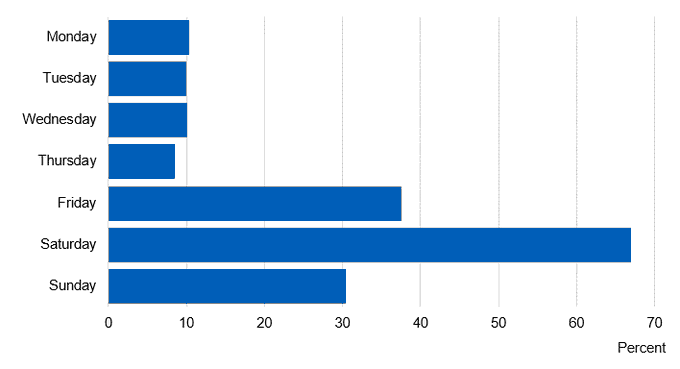
Underage drinking during the week. |
Furthermore, of those pupils who obtained alcohol in the last four weeks, they were most likely to have been given it by parents or guardians (71%), and a minority of pupils surveyed (49%) said their parents did not, or would not like them to drink alcohol.
When a logistic regression model was applied to explore which characteristics might be associated with pupils’ drinking in the last week, it found the strongest association with drinking was having parents who don’t discourage it.
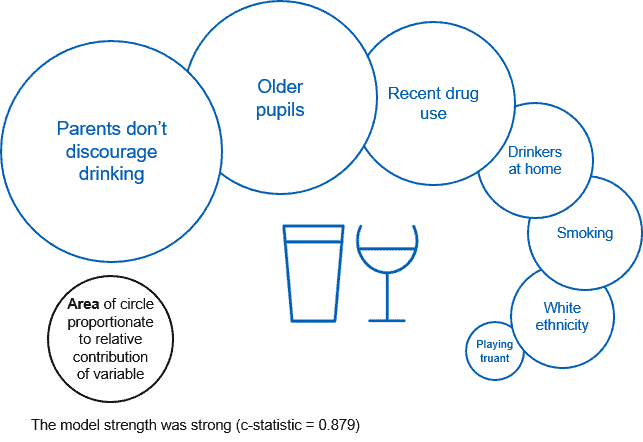
Factors associated with drinking in the last week. |
As well as alcohol, the survey also monitors smoking cigarettes and e-cigarettes, drug use, and wellbeing in different areas (life satisfaction, whether life is worthwhile, happiness, and anxiety). Trends in drug use are a complex picture as the survey methodology changed from 2016, but it is worth noting there is some evidence of a rise in drug use prevalence among young people.
In terms of wellbeing and alcohol, 36% of recent drinkers reported a high level of anxiety felt yesterday, compared to 27% for all pupils. Across all the wellbeing areas, low wellbeing was more common among pupils with multiple recent smoking, drinking, or drug use behaviours together.
Smoking, Drinking and Drug Use among Young People in England is based on a representative survey of 13,000 11–15-year-old schoolchildren, conducted in alternate years.
Alcohol does not impair our (moral) behaviour
Drinking influences empathy, but not moral judgment
20 August 2019 – A new study has found that alcohol consumption can influence a person’s empathy towards others, but not their moral judgments and actions.
Published in Psychopharmacology, a team of researchers from the University of Plymouth and the University of Bradford looked at the acute effects of alcohol on ‘affective empathy’ – the ability to respond with an appropriate emotion to another’s mental state – as well as moral behaviours based on reactions to traditional thought experiments and virtual reality scenarios involving moral dilemmas. The aim was to discover how drinking alcohol, empathy, and moral behaviour are related.
48 participants were administered either a placebo or alcohol in one of two dosages; low or moderate. Both pre- and post- intervention, participants completed a moral action and moral judgment task alongside behavioural measures of affective empathy. The research team discovered that while consuming alcohol at higher dosages might affect our empathy, making us respond inappropriately to other people’s emotions and reactions, it doesn’t necessarily change our personal morality.
Writing in The Conversation, lead author Kathryn Francis said: ‘It turns out that while we might believe that alcohol changes our personalities, it doesn’t. You’re still the same person after a drink – your existing sense of morality left intact. So while alcohol might affect how we interpret and understand the emotions of other people, we can’t blame our immoral behaviours on alcohol.
‘Drunken you has the same moral compass. And so you are responsible for your moral and immoral actions, whether you’ve had a few drinks or not.’
The study concluded that ‘future research should consider expanding the present investigation in order to determine if these effects generalise more broadly’.
Drink driving death numbers still stalling
Progress on drink driving injuries and deaths coming to a gradual stop
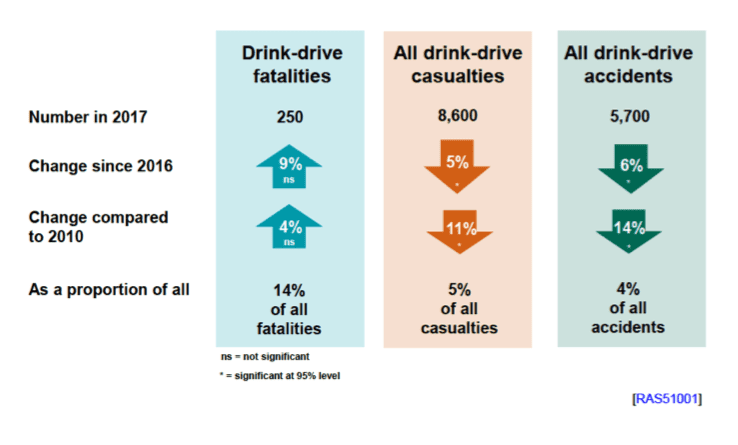
Drink-drive fatalities, casualties and accidents in Great Britain, 2017 |
28 August 2019 – Alcohol-related road casualties and deaths in Great Britain continue to plateau, as another year’s figures show no significant change in fatalities and small declines in injuries caused by drink driving.
The Department for Transport’s final estimates for 2017 show that there were 250 fatalities in drink-drive accidents where at least one driver or rider was over the alcohol limit, a small, not statistically significant increase on 2016, but still the highest estimated total since 2009. The number of fatal drink-drive accidents (220) stayed the same.
Small improvements occurred when injuries were included among the casualties / accidents figures: An estimated 8,600 people were killed or injured, a reduction of 5% from 9,040 in 2016, and the total number of accidents where at least one driver was over the alcohol limit fell by 6% to 5,700 in 2017.
However, while small improvements occurred in the total figures, it is important to note that there were small increases in the number of serious injuries resulting from drink driving. The number of serious injuries from drink-drive accidents rose by 11% (1,000 to 1,110), and from drink-drive casualties by 10% (1,250 and 1,380) between 2016 and 2017.
Responding to the figures, RAC Head of Policy Nicholas Lyes said:
‘These figures are disappointing and show that much more needs to be done to eradicate the scourge of drink-driving. The data shows that no discernible progress has been made for nine years in reducing the number of people killed in road traffic collisions where at least one driver was over the legal drink-drive limit.
‘The Government should be looking closely at all its options, even reviewing the drink-drive limit. But ultimately, it is absolutely vital that we have police enforcing laws and increasing roadside breathalyser testing so that law breakers know they will be caught.’
ALCOHOL SNAPSHOT – Parental permissiveness the best predictor of underage drinking
As discussed elsewhere in the Alert, NHS Digital’s regular survey Smoking, Drinking and Drug Use among Young People in England was released earlier this month. Published every two years, the survey is the best available source on trends in underage drinking in England. In this year’s edition, the authors analysed how different factors affect 11–15-year-old children’s likelihood of drinking regularly. The chart below shows their findings, with a larger bubble representing a stronger association.

Factors associated with drinking in the last week |
It shows that the single best predictor of whether a child had drunk alcohol in the last week was their parents’ attitudes. Children who said that their parents let them drink as much as they like had odds 22 times higher of having drunk in the last week than those whose parents disapproved of their drinking. This was a better predictor than the child’s age, whether they take drugs or smoke, whether they play truant or their ethnicity.
While these associations are not necessarily causal, they offer some support to the theory that parenting plays an important role in determining whether children choose to drink. A 2016 IAS report suggested that changes in parenting habits, including lower willingness to condone drinking, may help explain the decline in youth drinking in recent years. Concerningly, the proportion of children in the survey who say their parents do not or would not approve of them drinking has fallen since 2014, from 56% to 49% in the most recent wave.
Podcast
Our monthly podcast features interviews with experts from across the sector.
Gambling industry harms and parallels with the alcohol world
Will Prochaska –
Coalition to End Gambling Ads

